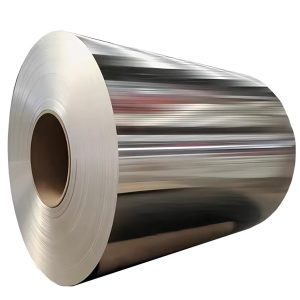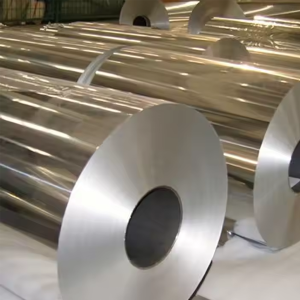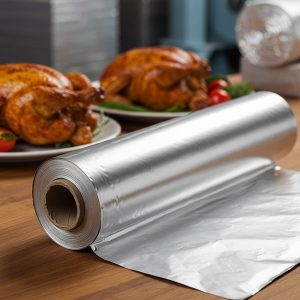
Aluminium foil is a versatile material used across industries — from food packaging to insulation and composite films. It combines flexibility, durability, and excellent barrier properties. However, not all aluminium foils are the same: the performance of each depends on its alloy composition, material temper, and processing technique.
1. Aluminium Foil Alloys and Composition
Commercial aluminium foil is never 100% pure aluminium. Instead, it is produced from alloys containing small quantities of elements such as chromium, copper, iron, magnesium, manganese, silicon, titanium, and zinc.
Even when these elements are added in fractions of a per cent, they significantly affect the foil’s mechanical strength, corrosion resistance, and formability.
Common international alloy designations follow the EN-AW standard, for example:
EN-AW 1050 – containing at least 99.5% aluminium, known for its ductility and corrosion resistance.
EN-AW 8079 – widely used for flexible packaging and lamination.
In some regions, such as Germany, older DIN notations are still used (e.g., AlMg3 corresponding to EN-AW 5754). While price differences between alloys are minor, availability can vary depending on production volume and demand.
2. Tempers: From Soft to Hard Aluminium Foil
The mechanical properties of aluminium foil depend not only on its alloy but also on its temper (the condition achieved after rolling and heat treatment).
Foil can be classified as:
Soft (O temper)
Quarter Hard
Half Hard
Three-Quarter Hard
Hard (H temper)
After multiple rolling operations, aluminium becomes hard and less ductile. Heat treatment in ovens (annealing) restores softness, allowing better formability and removing residual rolling oils.
Soft foil is commonly used in laminates and coatings, as adhesives and lacquers adhere poorly to oily or hard foil surfaces. Alternatively, foils in hard temper can be chemically degreased to remove oil residues without the need for heating.
3. Laminated and Composite Aluminium Films
Aluminium foil is frequently used as part of laminated structures to combine the strengths of multiple materials.
Common laminates include:
Duplex laminates: Aluminium + PE
Triplex laminates: PET + Aluminium + PE
Multilayer laminates: e.g., Aluminium 7 μm + PE 15 g + Kraft Paper 50 g/m² + Flame-retardant PE 25 g
The process of joining layers is known as lamination. When polyethene (PE) is applied as a molten adhesive layer, it’s referred to as PE-lamination. If the PE is used on a single side only, the process is called coating or extrusion.
These composite films are used in food, pharmaceutical, and insulation applications, where moisture resistance, mechanical strength, and thermal stability are critical.
4. Mechanical and Physical Properties
The key mechanical characteristics of aluminium foil are:
Tensile strength – resistance to pulling forces
Yield strength – stress at which deformation begins
Elongation – ductility before breaking
For laminates, adhesion strength between layers is also important. Other functional parameters include gloss, water vapour permeability, gas barrier performance, and thermal emissivity — each essential depending on the end-use.
5. Dimensions and Roll Specifications
Aluminium foil is available in various thicknesses, widths, and roll configurations.
Thickness: typically 6 μm to 200 μm (micrometres)
Width: usually measured in millimetres or centimetres
Roll formats: defined by weight, outer diameter (OD), and length per reel
Large industrial reels may use steel cores (ID 150 mm or 152 mm), while smaller reels often use cardboard cores (38–76 mm). Laminated foils are usually wound on 76 mm cardboard cores.
Small-quantity orders are often slit and rewound from mother reels — an additional step that increases cost per meter due to handling and cutting.
6. Aluminium Sheets and Cut Formats
Aluminium foil can also be supplied in cut sheet formats, ideal for laboratory use, packaging, or decorative applications. Since these are cut from coils or strips, they tend to be more expensive per unit area, especially for low-volume orders or special sizes.
7. Applications of Aluminium Foil
Aluminium foil is used globally in:
Food and beverage packaging
Pharmaceutical blister packs
Insulation and HVAC systems
Cable and electronics shielding
Lamination with PET, PE, or paper
Its versatility makes it indispensable for industries requiring lightweight, impermeable, and recyclable barrier materials.
Contact GengFei Steel
GengFei Steel supplies high-grade aluminium foil and composite films for industrial, packaging, and insulation applications worldwide.
We offer customised alloy grades, tempers, and roll sizes to meet your production needs.
📧 Email: [email protected]
📱 WhatsApp: +8619138164778







